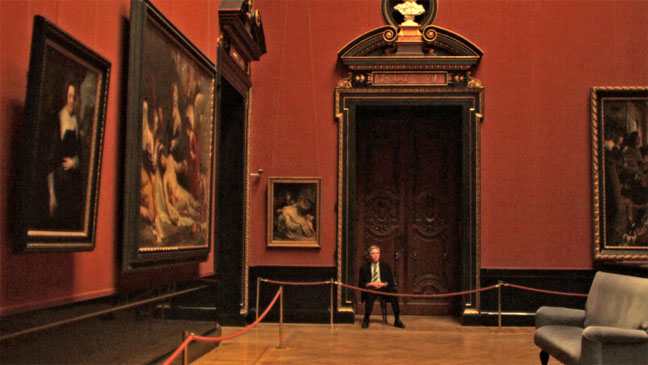Title: Museum Hours
Cinema Guild
Director: Jem Cohen
Screenwriter: Jem Cohen
Cast: Mary Margaret O’Hara, Bobby Sommer, Ela Piplits
Screened at: Review 1, NYC, 6/4/13
Opens: June 28, 2013
When you look at a bunch of grade-school kids on their obligatory trip to the Kunsthistorisches Art Museum in Vienna, you may wonder what’s the point of the trip. Like American youngsters, they compete with one another in the game of who can look the most bored, or they actively make fun of the paintings. Some of the artistic creations do get their attention, specifically those dealing with severed heads as in “Judith Beheading Holofernes,” with a hoped-for follow up on how the assertive woman got the man drunk enough to act out Grand Guignol. Then again, Jem Cohen, who wrote and directs “Museum Hours,” leaves a dedication during the end credits “Tomy parents, who took me to museums.” OK, then one percent of adults will visit these quiet institutions voluntarily just as one percent will see Shakespeare’s plays without having to ask “Will this be on the exam?”
There is one other good reason for a guy or a gal to go to museums, and that’s to pick up a member of the opposite (or same) sex since, after all, it’s easy to start a conversation with a handsome or pretty stranger about that person’s thoughts on a given painting. Such is the case, but only in a way, with Anne (Mary Margaret O’Hara) and Johann (Bobby Sommer). In Cohen’s story, Anne, a Montréal resident who must borrow money to get to Vienna, feels obligated to see her comatose cousin and has no idea how to get to the medical center. Probably without the euros to take a taxi, she walks around the Kunsthistorisches and asks Johann, the museum guard, for directions by tram. Johann speaks fluent English as well as German. They get to chatting and Johann, who is presumably lonely just as Anne is, even agrees to show her the town and to visit her cousin as well.
Johann had taught woodworking in a vocational school in his younger days and now wants to continue making himself useful, which he does throughout his Platonic relationship with the woman. We don’t know much else about their backstories—she is between jobs—but we needn’t have that information.
Cohen’s aim in writing and directing is to show that life follows art. In a late scene, the most vivid, he shows us an old woman walking up an inclined road and turning right, giving the impression that she has just escaped from a 16th Century painting, perhaps by the Flemish Renaissance artist Peter Bruegel the Elder. Bruegel is said to have disguised himself as a peasant to see how the untermenschen live, then proceeded to capture their spirit in heavily detailed works. Even Johann, who has been a guard for six years, notes that he sees something new in Bruegel’s works each time he looks.
As for those grade school kids, they might have enjoyed a scene, albeit one that’s in Cohen’s imagination, of guests looking at paintings to show that, like Adam and Eve, they consider the human body nothing to be ashamed of.
I don’t think Cohen quite makes the point that the works on the museum walls reflect life in Vienna, though he points his 16mm camera at ordinary objects on the street to show that these are notable just as are the theatrical. The movie is not difficult to understand; after all this is no “Hiroshima Mon Amour” or “Last Year at Marienbad,” but it is on a high intellectual plane. Maybe the audience hopes for at least some melodrama to break up the long takes and talky commentary by Johann and Mary. While this film was screened for critics (on June 18th), “World War Z” was also offered to journalists at the same time. The two couldn’t be more different.
Unrated. 106 minutes © 2013 by Harvey Karten, Member, New York Film Critics Online
Story – B-
Acting – B
Technical – B
Overall – B
